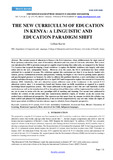| dc.contributor.author | Kaviti, Lillian | |
| dc.date.accessioned | 2019-03-19T07:49:12Z | |
| dc.date.available | 2019-03-19T07:49:12Z | |
| dc.date.issued | 2018 | |
| dc.identifier.citation | Kaviti L. ": The new curriculum of Education in Kenya: A Linguistic and Education Paradigm shift. ." In the Journal of Humanities and Social Sciences peer reviewed reviewed by the international organization of Scientific Research International Journal of Scien. 2018. | en_US |
| dc.identifier.uri | http://hdl.handle.net/11295/106450 | |
| dc.description.abstract | The current system of education in Kenya is the 8-4-4 structure, where children study for eight years of
Basic (primary) education, four years of Secondary education and four years of University education. This system
was introduced in 1985 to promote man-power capable of performing blue collar jobs, as compared to the former
7-6-3 system that targeted developing a local workforce to replace the British workforce who largely held white
collar jobs in the new, independent Kenya. However, over the years, the 8-4-4 curriculum has been widely
criticised for a myriad of reasons. The criticisms against this curriculum are that it is too heavily loaded with
content, purely examinations-oriented, and generally violating the Rights of the Child by placing undue physical
and psychological pressure on learners. In order to address this problem therefore, a new curriculum was hastily
crafted and taken through a rushed pilot drive in April 2017 and is expected to replace the current 8-4-4 system by
January 2018. Admittedly, this new education system addresses some of the weaknesses of the current 8-4-4
education system, since it is competency-based and focuses more on skills acquisition as opposed to a purely
knowledge-based acquisition system. The issues addressed in this paper is how this new and hurriedly crafted
curriculum (as well as the introduction of Free Secondary School Education) will be implemented by teachers who
are yet to come to terms with the new paradigm shift of teaching and learning. The second issue addressed is
whether the crafters of this system took into consideration children’s rights, or whether at all, the system was
crafted from a child-centred perspective. The concerns are that apart from the manner in which this syllabus was
been crafted and planned for implementation, if not reviewed comprehensively may not only violate the rights of
future generations of children, but also enhance negative ethnicity from a linguistic perspective | en_US |
| dc.publisher | University of Nairobi | en_US |
| dc.rights | Attribution-NonCommercial-NoDerivs 3.0 United States | * |
| dc.rights.uri | http://creativecommons.org/licenses/by-nc-nd/3.0/us/ | * |
| dc.subject | Learners, 8-4-4 system, 2-6-3-3 new curriculum, Continuous Assessment Tests, Bloom’s Taxonomy of Learning, Montessori Approach, Bests interests of the Child, Indigenous languages. | en_US |
| dc.title | The New Curriculum of Education in Kenya: a Linguistic and Education Paradigm Shift. | en_US |
| dc.type | Book chapter | en_US |



